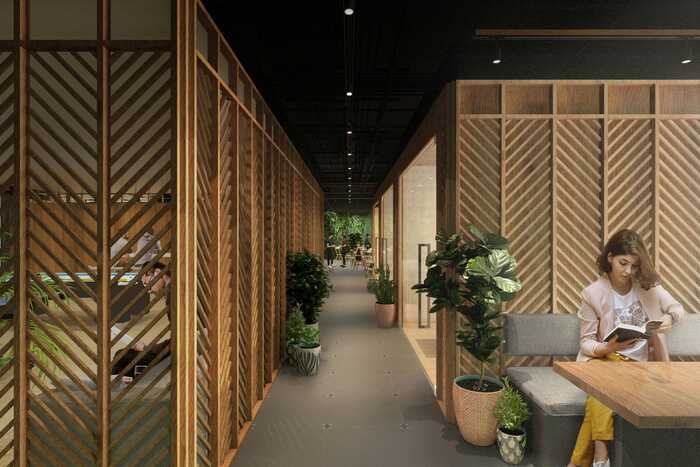Designing an office is an exciting opportunity to create a functional and inspiring workspace, but without a well-planned budget, costs can quickly add up. A carefully developed budget ensures you allocate resources efficiently while achieving your design goals.
Here’s how to plan a budget for your office design, including the importance of hiring a professional commercial interior designer.
1. Establish Your Budget Early
Before diving into design ideas, set a clear budget range. A well-defined budget helps you avoid overspending and ensures that every dollar is allocated effectively. Consider factors such as:
The size of the office space – Larger spaces naturally require a bigger budget due to increased materials and labor costs.
The scope of redesign – Determine if you need a full renovation or just cosmetic updates. Full renovations involve structural changes, while minor updates focus on aesthetics and functionality.
Furniture, fixtures, and technology needs – List out essential purchases such as desks, chairs, storage solutions, and digital infrastructure.
Professional services, including designers and contractors – Hiring experts can streamline the process, but their fees must be factored into your budget.
Contingency fund – Unexpected expenses often arise, so setting aside 10-20% of the total budget can prevent financial surprises and delays.
2. Define Your Priorities
Not all office design elements carry the same importance. Clearly defining priorities helps you make informed decisions and cut costs where necessary. Consider:
Must-haves: Ergonomic furniture, proper lighting, and functional meeting spaces.
Nice-to-haves: Artwork, decorative lighting, and high-end materials.
Employee feedback: Ask your team for input on what changes would most improve their workspace experience, ensuring your budget is spent on valuable upgrades.
Long-term needs: Plan for future growth and expansion so your redesign remains effective for years to come.
3. Get Quotes and Compare Costs
Pricing can vary significantly between suppliers and service providers, so obtaining multiple quotes ensures you get the best value for your budget.
Furniture and decor: Compare prices from office furniture suppliers, online retailers, and second-hand stores.
Construction and renovation: Get detailed estimates from multiple contractors and ask about potential hidden costs.
Technology: Factor in costs for wiring, internet setup, and smart office solutions like automated lighting or security systems.
Design services: Many commercial interior designers offer tiered pricing based on services provided, so choose one that aligns with your budget and needs.
4. The Value of Hiring a Professional Commercial Interior Designer
Hiring a professional interior designer may seem like an added expense, but their expertise can lead to long-term savings and a more efficient office layout. Here’s why it’s worth considering:
Space optimization: A designer ensures every square foot is used effectively, reducing wasted space and maximizing productivity.
Access to discounts: Designers often have industry connections that provide discounts on furniture, materials, and fixtures.
Avoiding costly mistakes: Poor design decisions can lead to expensive corrections later. A professional helps prevent these issues upfront.
Project management: Designers coordinate with contractors, suppliers, and vendors, keeping the project on schedule and within budget.
5. Consider Phased Implementation
If your budget is tight, consider breaking the project into phases rather than attempting a complete redesign all at once. This approach allows you to spread out costs over time while still making meaningful improvements.
Phase 1: Focus on critical areas like workstations and meeting rooms.
Phase 2: Upgrade common areas such as break rooms and reception spaces.
Phase 3: Enhance aesthetics with decorative touches and branding elements.
6. Balance Quality and Affordability
It’s important to invest in durable, high-quality items where it matters most while finding budget-friendly alternatives for less essential elements.
Splurge on: Ergonomic chairs, adjustable desks, and high-traffic flooring.
Save on: Office accessories, wall decor, and temporary partitions.
Repurpose existing furniture: A fresh coat of paint or new upholstery can breathe new life into older pieces without the cost of replacements.
7. Plan for Long-Term Costs
Office design isn’t just about the initial cost—it’s also about long-term sustainability. A smart budget accounts for ongoing expenses such as:
Maintenance and repairs – Regular upkeep prevents small issues from becoming costly problems.
Energy efficiency – Investing in LED lighting, energy-efficient HVAC systems, and smart thermostats can lower utility bills over time.
Future expansion – If your business is growing, consider adaptable furniture and modular office layouts that can evolve with your needs.
8. Track and Adjust Spending
Throughout the redesign process, track expenses carefully to ensure you stay within budget. Use budget tracking software or spreadsheets to monitor costs and adjust allocations as needed.
Reallocate funds – If you save money in one area, consider investing it in another priority.
Address overruns quickly – Identify and resolve budget overruns before they become major issues.
Maintain documentation – Keeping records of all purchases, contracts, and invoices helps manage spending and provides insights for future office projects.
Final Thoughts
Developing a well-structured budget is key to a successful office design project. By prioritizing needs, hiring a professional where it makes financial sense, and tracking expenses, you can create a functional and visually appealing workspace without exceeding your budget. Smart planning ensures that your investment pays off in both efficiency and aesthetics, helping your team thrive in a well-designed office environment.


